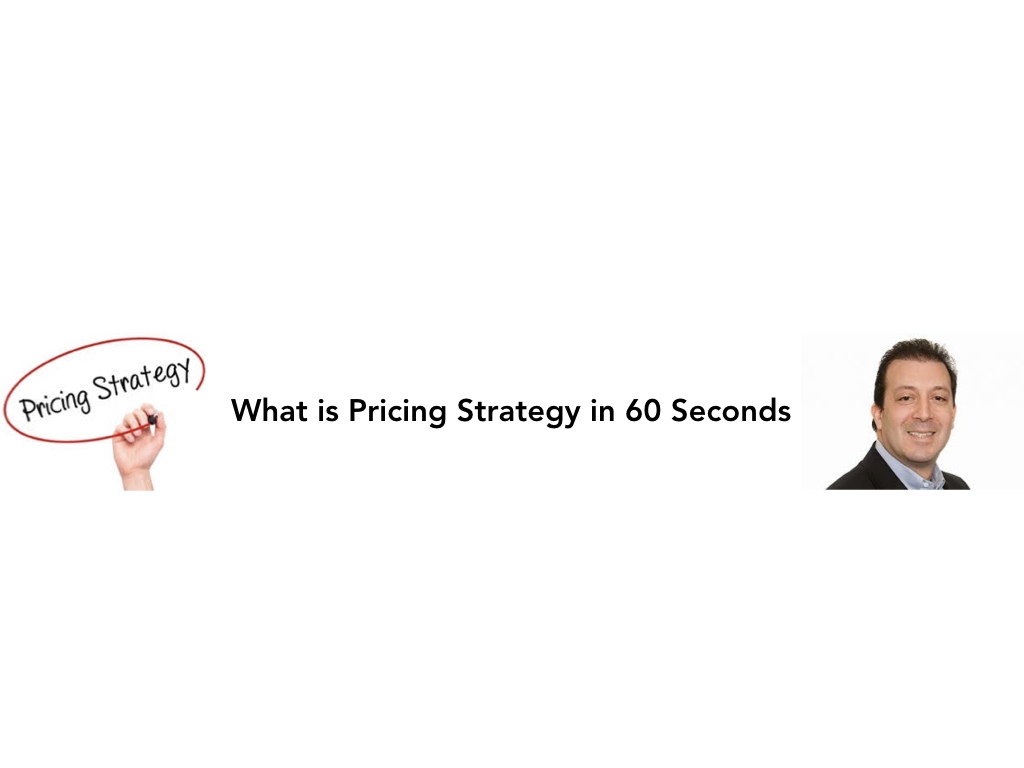
How to optimize your landing pages in 60 seconds using the acronym, V.E.L.O.C.I.T.Y

How to optimize your landing pages in 60 seconds using the acronym, V.E.L.O.C.I.T.Y

Do you want to know how to define and implement a successful sales strategy? There are several key components. Find out in the next 3 minutes.

Pricing Strategy is probably the most important and most overlooked area in all of marketing. In 3 minutes, I break it down for you and focus on how to develop and scale your pricing to drive revenue.


Do you remember when MTV was the best way to get in front of the teen and young adult audience? Once mobile technology became popular, it didn’t take long for that age group to be on the move.
In no time, videos were streaming on iTunes. Though teens continued to watch, viewership dropped. Then came instant messaging, followed by social media. For a time, Facebook gave advertisers their niche audience of young consumers congregated in one place.
That is until Snapchat and Instagram came along.
To add to the challenges of the last couple of decades, smart speakers are now in about one-quarter of U.S. homes, and podcasts are gaining popularity. In fact, about 50 percent of households now say they listen to podcasts, with a majority of them joining the trend in just the last three years.
According to whypodcasts.org, 38 percent of listeners are age 18-34, and 64 percent listen on their smartphones.
As technology-driven change changes direction, it is easier, and far more profitable, to change direction with it. “It’s easier to ride a horse in the direction it is going.” That’s what my grandfather told me as a little boy working with him on his farm in Texas.
Every company, regardless of size, knows they must advertise if they are to grow. Yet with all the money that is being spent, it is increasingly difficult to get your message to the right audience.
This is where it pays to be anticipatory. Using the systemic method outlined in my Anticipatory Organization Model, you can ready your organization for the disruptive transformations ahead.
In my work as a technology and business futurist, I have found the most effective way to approach becoming an AO is to focus on demographics, government regulations, and technology. In addition, it is always good to know which consumer technology trends will stick around. I call these Hard Trends (as opposed to Soft Trends, which may come and go).
Today, content channels such as social media, Apple Watch, and Google Home provide the perfect vehicles for interactivity at any time, in any place, and with any person.
Advertisers know the harsh reality: Running an ad on a major television network and supplementing it with web banner ads is no longer a guarantee of reaching the audience.
If you use my Hard Trends Methodology to look ahead to the future of marketing, you’ll be able to anticipate the fast-moving innovations to come. New devices are likely to be developed, and their connectivity doesn’t show signs of slowing any time soon.
Learn to be anticipatory—start with my book, the Anticipatory Organization, available on Amazon.com.

“Danger lurks in many forms. Don’t let the concealed danger of a handshake endanger you.” -Greg Williams, The Master Negotiator & Body Language Expert
“I didn’t come here to learn about handshakes. I came because I wanted to become a better #negotiator.” Those were the unfortunate comments of a seminar attendee. He didn’t realize that he’d overlooked a huge gambit in the negotiation process.
A #handshake conveys important information. The more people exchange them between one another, the more information they convey. It can say, I’m feeling overly optimistic today. It can say, my mood is somewhat deflated. It can also say that I’m going to dominate you because I feel superior today.
Very few people understand the value transmitted when they clasp someone’s hand. Are you aware of such messages when you shake someone’s hand?
After gaining insights from the following information, you’ll never look at, sense, or interpret a handshake as you’ve done in the past.
Some people equate a weak or wimpy handshake with someone of the same character. Be careful of the assumptions you make.
A weak or wimpy handshake may send a silent message of subservience. It can also be the disguise of someone that’s significantly stronger in character than the handshake conveys. It’s one tactic that good negotiators use to dupe the other negotiator into perceiving a false sense of weakness. That’s done to acquire insight into what the other negotiator might do once she sensed that she was dealing with a mentally weaker opponent.
If you wonder about the validity of such a person, shake hands several times during your interactions. Note the slightest degree of change in the firmness of their handshake. To the degree change occurs, it’ll serve as a barometer indicating a change in character.
The delivery of a bone-crushing handshake can be an attempt to display strength and dominance. It can be someone’s lack of recognition of their strength related to the hand they’re shaking. It could also be an attempt to conceal weakness.
I recall a business associate telling me that I shook his hand too hard. I knew I possessed a firm handshake but I’d not considered it to be bone-crushing. My associate reiterated his statement a few times. After that, I was always more attentive to not shaking his hand with the prior degree of intensity that I’d used before.
The point is, if you do have a firm handshake, know when to moderate it based on the circumstances. If someone delivers a bone-crushing handshake upon you, and it’s painful, consider saying something. Then, note if any change occurs. If it does, the person is displaying more alignment with you. If it doesn’t, the person doesn’t care how you feel. In either case, you will have gained valuable insight into the person.
The person controlling a handshake is the one that releases it last. A handshake on average last about five seconds. Thus, the person holding the hand of the other individual the longest is stating that they’re not ready to release that person.
Take note when someone extends a handshake pass what’s normal for the situation. They may be sending a subliminal message that they’re superior. They might also be holding your hand longer to comfort you or themselves. Therefore, note when such occurs and the situation in which it happens. Doing so will allow you to gain additional insight as to why they’re committing that act.
In every negotiation, note its beginning through the information sent via a handshake. If you become attuned to its intent, you’ll have greater insight into that person. That insight will add additional information about how you can negotiate better with them … and everything will be right with the world.
Remember, you’re always negotiating!
Listen to Greg’s podcast at https://anchor.fm/themasternegotiator
After reading this article, what are you thinking? I’d really like to know. Reach me at Greg@TheMasterNegotiator.com
To receive Greg’s free “Negotiation Tip of the Week” and the “Sunday Negotiation Insight” click here http://www.themasternegotiator.com/greg-williams/
#Danger #Handshake #negotiator #BodyLanguage #Liar #Beware #Negotiate #Process #Power #Powerful #Emotion #Business #Progress #SmallBusiness #Negotiation #NegotiatingWithABully #Perception #emotionalcontrol #relationships #HowToNegotiateBetter #CSuite #TheMasterNegotiator #ControlEmotions #BodyLanguageSecrets


When things are running smoothly, all we need to do is have the proper management to keep the trains running on time. This statement, combined with the idea that 99.9% of the time things are going well, is what leads to businesses falling behind, losing market share, and ultimately facing failure in the great game of business.
Because of this, complacent leadership should be one of the most significant weaknesses in any business’s strategy. The simple fact is that that world is ever-changing; our industries, markets, people, are all dynamic. Nothing is ever static.
Being an effective leader means that you cannot only deal with change–this implies that you are solely reactive–but to remain ahead of it.
Remaining ahead of change requires two things, knowledge and adaptability.
Today’s leaders must have a strong knowledge base around not only their sphere of influence –day-to-day activities, people, techniques–but also around the external factors of what affects each of these. They have to be able to spot trends, discover new opportunities, and learn about challenges before they become a substantial obstacle.
From this knowledge grows adaptability. We have to maintain the mindset that just because something works today, it will not necessarily be the best option tomorrow. Leaders must be able to adapt their teams to changing conditions, circumstances, and ideas. Almost all of these challenges will be because of external factors. These factors can come from anywhere, competitors, customers, suppliers, anyone that a team or business interacts with on a regular–and often indirect–basis.
A leader is never in direct control of all of the activities around them, but neither should they become purely reactionary. Great leadership resides in carefully walking the balance between the two; recognizing challenges and opportunities, adjusting where needed, and taking action when the time is right.
Ed Brzychcy is former U.S. Army Infantry Staff-Sergeant with service across three combat deployments to Iraq. After his time in the military, he received his MBA from Babson College and now coaches organizational leadership and growth through his consultancy, Blue Cord Management.


This is an em dash: — It has the approximate width of a capital H. The poor em dash is perhaps the most misunderstood and misused of all punctuation marks. Used well, it adds emphasis and precision to your writing.
This form of punctuation is a newcomer to the world of writing and printing. It’s believed to have originated with the Gutenberg Bible, but it wasn’t widely used until the 1700s. That is short in the writing world; this means it hasn’t been around long enough to have hard-and-fast rules attached to its use.
The easiest rule about the em dash is that it can be used to indicate an interrupted thought.
“Let’s go to the store—oh, I didn’t notice that you were reading.”
“I had the greatest time at—watch, you’re about to step into a puddle.”
“Yes, I really want to hear your story—oh, hi, Max, did you have a nice time last night?”
In the above examples, no other form of punctuation will work.
Em dashes can also be used for a less extreme form of interruption.
“I was going to the board room—but I changed my mind because the fire alarm went off.”
Unlike in the examples above, the em dash doesn’t mark a complete change of subject. It could also be replaced by a comma.
“I was going to the board room, but I changed my mind because the fire alarm went off.”
Here I prefer the first version because I think of the em dash as a more dramatic form of punctuation, which in this case describes a dramatic event. It’s saying, “Pay attention to this.”
Here’s another example of using the em dash in a dramatic way.
“Pfizer, the largest drug manufacturer, raised prices for 40 drugs—with some increases hitting 9 percent.”
The em dash can mark an afterthought, especially when it’s intended to be humorous or ironic.
“I don’t believe in ghosts—except the one in my closet.”
It can connect a series of subjects with a conclusion.
“Yoga, chi kung, tai chi—these are excellent methods of gentle exercise.”
In fairness to other forms of punctuation, you could also write
“Yoga, chi kung, and tai chi are excellent methods of gentle exercise.”
Em dashes can be used to surround a parenthetical set of words.
“The Presidential hopefuls—Biden, Harris, and Hickenlooper—disagree sharply on foreign policy.”
Commas or parentheses could be used here, but they wouldn’t set off the names so distinctly.
“The Presidential hopefuls, Biden, Harris, and Hickenlooper, disagree sharply on foreign policy.”
“The Presidential hopefuls (Biden, Harris, and Hickenlooper) disagree sharply on foreign policy.”
Most grammarians agree that this is the biggest danger of em dashes. Keep in mind that they break up a line of thought and can thus lead to choppy and disjointed writing—and reading.
If your paragraph has more than one em dash (or two, in the case of em dashes setting off words, as above), replace them with commas or parentheses.
Remember, above all, that an em dash is best used for dramatic effect. This can highlight your prose. Used too often, it will simply overwhelm it.
Need a skilled editor? Pat Iyer Is a C Suite Network Advisor, ghostwriter, and editor. Reach her through her website at www.patiyer.com.

“To achieve more, you must know what more is and why you’re waiting to acquire it.” -Greg Williams, The Master Negotiator & Body Language Expert
“I want to be fit and in shape. But I don’t put forth the effort to exercise. Thus, I’m not in shape. I have low-energy. And my physical appearance could be better. Still, I want the results of looking good, feeling good, and being fit. I don’t know what I’m waiting for before committing the actions required to achieve those goals!” Those were the words spoken by an associate as he lamented his plight. Have you pondered such thoughts about the goals you’ve sought to achieve? Have you thought about the consequences that lie in wait tomorrow, as the result of not beginning the quest of your goals, today?
Do you know what you’re waiting for before moving in a more positive direction? It’s a question that everyone needs to evaluate when assessing why they’re not in a better place – at a better point in life. When you engage in activities that don’t support the goals you wish to achieve, you should ask yourself, what am I waiting for? When you find yourself veering off-track of a successful endeavor, take note of where you’re headed. And if you don’t like the distant destination that you’re headed towards, ask yourself, what am I waiting for before getting back on track.
To be more successful in life, you must be self-reliant. That means as the cliché states, you must adopt a mindset that states, “if it is to be, it’s up to me.”
Everyone becomes encumbered by life’s activities at times. And yet, everyone always spends their time doing what’s most important to them. I’ve issued that summons to individuals over time. Some have stated that they only participate in activities that advance their goals. When questioned about their engagements in activities that don’t progress their goals, they sheepishly admit that it does occur sometimes.
The point is, everything you engage in is the priority that you’ve chosen to invest your time. Because, you’re stating by the fact that you’re engaged in that activity that it’s the most important thing to you at that time – to thine self be true.
Recognize what you do as being what’s most important to you when you’re doing it. Don’t sugarcoat it! You’re only playing with your mind if you don’t acknowledge that fact. There’s no right or wrong or need to assess blame. Just realize what reality is. You can’t address a situation, good or bad unless you recognize it for what it is. Once you examine your actions in the light of reality, you’ll be in a better mental space to take corrective actions. But you’ll only do that if you really want to achieve that ‘thing’ that you say is so important to you. Once you start on the path of achievement and stick to it, you’ll feel better about yourself and the achievement of your goals … and everything will be right with the world.
What does this have to do with negotiations?
In every negotiation, timing plays a key role in when you should extend your offers and when you might obtain what you seek. Thus, you must become keenly attuned to your timing. If you hesitate in making a request, a demand, a concession (yes, they are different), you should question yourself as to what you’re waiting for. If you wait too long, you’ll miss your opportunity to acquire more. If you pursue too soon, you could meet the same fate or worse, lose what you’ve acquired.
It’s stated that timing is everything. That’s especially true when negotiating. Thus, always be mindful of how you utilize your time. And note the waiting period that you engage in as to why you wait sometimes.
Remember, you’re always negotiating!
Listen to Greg’s podcast at https://anchor.fm/themasternegotiator
After reading this article, what are you thinking? I’d really like to know. Reach me at Greg@TheMasterNegotiator.com
To receive Greg’s free “Negotiation Tip of the Week” and the “Sunday Negotiation Insight” click here http://www.themasternegotiator.com/greg-williams/
#waiting #Negotiate #Process #Power #Powerful #Emotion #Business #Progress #SmallBusiness #Negotiation #NegotiatingWithABully #Power #Perception #emotionalcontrol #relationships #HowToNegotiateBetter #CSuite #TheMasterNegotiator #ControlEmotions


Many experts agree that selling with perspective/insight improves selling performance, but most ignore the role played by business acumen. Business expertise is foundational to perspective selling success. Ignoring it is a mistake; best case, you can win some more opportunities, but at suboptimal margins. Worst case: your insight selling investment won’t get you anywhere.
Perspective selling can be a huge difference maker. CSO Insights found that companies who incorporated perspective into their approach had 12% higher win rates. This rose to 23% higher win rates for companies who master perspective. The data was conspicuously silent on profit margins of those won deals. Thus, selling with perspective can be powerful, but your mileage can vary widely, depending on how you implement.
Unfortunately, some sales training companies cover business expertise with little more than a vague hand wave. Their treatment: “Take your business acumen…you know, that business acumen that you have (right?)…and use it to provide some valued perspective”. Apparently, hope is a strategy.
Others tell us to apply our business acumen to expose an unrecognized problem, unrecognized solution, unforeseen opportunity, or to bring a third party’s capability to bear. Those are great suggestions for how to use already-established business acumen.
I’ve heard business acumen (for sellers) described as “understanding how your customers make money”. That’s a great start. Adding “to the point you know how your offer can help them make even more” should become the standard for every customer-facing person in your organization.
SWOT (strengths, weaknesses, opportunities, and threats) analysis is better than nothing but doesn’t help a seller develop very meaningful insights. It doesn’t help your people meet the standard above.
“Understanding growth drivers” sounds helpful, but don’t you need business acumen to for that level of understanding?
Sellers need a set of tools which help them understand how business works well enough to look at a prospect company with a “mechanic’s eye”: ability to diagnose what’s working well, what’s not, and how their offer can help. My business acumen framework covers a business in enough depth to help sellers do just that. Here’s a diagram of the major parts of a customer’s world: What elements of their environment shape a business, internal elements that shape their world view. On the right, is a list of some of the major outcomes you might be able to help them change.

Because this framework is about your customer’s world, it works with any sales training system or methodology. Contact me if you’d like to learn more about this overview.
I’ve seen leveraging business insights to “provide perspective” and “provide insight” as one step in the selling process. I reject this; such a suggestion shows a fundamental misunderstanding of business perspective.
Business acumen helps a seller throughout the arc of the customer experience:
That’s why I promote a company-wide “value culture”. In a value-focused culture, a lot of roles participate and several loops get closed.
Business acumen is a backdrop to a phased process, each phase of which blends into the next. Thus, Business acumen is foundational to professional selling.

Initially, a seller should uncover needs, value gaps, and potential customer outcomes. I have a tool called value networks which helps guide this process more efficiently (these are company-specific). In this phase, sellers need to envision all of the parts of a customer organization the selling company’s offer might impact. As customers have become more siloed, this job has become more challenging. My value networks help make this easier, and work with any sales training system or methodology.
During this process, a seller should be able to develop value (build the desirability of various outcomes) in the mind of various buying personas. The diagram in this middle circle reminds sellers that they need to develop value while they can. Once a prospect has decided you’re on the shortlist, it gets increasingly difficult to “sell value”.

To begin the closing process, a seller needs to connect their solution to customer-validated outcomes, recap the value of those outcomes, and then position the solution based on that value. Pricing – even premium pricing– should reflect the value of those outcomes and share a win-win philosophy. I have often experienced higher customer preference at premium prices once the customer-validated value is used alongside the price for context.

Perspective selling is powerful. It increases close rates and strengthens customer relationships. With a few simple additions, it can do all of those things more effectively…and more profitably. That is, you can close more deals at a higher – and more customer-appreciated – price. Since pricing power is profit power, those small adjustments make a huge difference.
Comment below. If you found this valuable, like this article and/or share with your network. If you’d like to learn more, please contact me.
To your success!

“Taking risks can be risky if you don’t control the risks you take.” – Greg Williams, The Master Negotiator & Body Language Expert
Positioning in a #negotiation impacts a #negotiator’s ability to #negotiate before the negotiation begins. Because the way you position yourself determines how the other negotiator will perceive you. And it’ll regulate your interactions. Thus, to be a better negotiator, you must #control any risky #positioning that might impact a negotiation.
Everyone considers what they might encounter before they engage in an activity – that’s especially true in negotiations. And it’s better you shape their perception before they do. Doing so delivers the image you wish them to have of you compared to the haphazard perspective they might create.
The following are examples to control your positioning before a negotiation occurs.
You’re perceived as an influencer when you surround yourself with those that influence others – that allows you to become better positioned. To advantage your position, consider becoming seen with the influencers that’ll have the greatest impact on those that you wish to influence. That will improve your positioning based on how others perceive you.
People will attempt to control your message. And they may hijack its intent to serve a purpose that’s better aligned with their goals, not yours. To oppose their efforts …
Words control emotions. And emotions control perceptions. To control your positioning better, control the words that control your message. As an example, depending on the situation, it may be beneficial to use the word squabble versus fight (e.g. we had a squabble) – that’s less impactful than, we had a fight. The exchange of those two words alters the perception of the situation.
When it comes to controlling your positioning, perception is reality. Your integrity intentions can be in alignment with your actions and if someone taints it with their ill-will, you could become seen as someone with less integrity. That’ll impact the way the other negotiator interacts with you. That could be to the detriment of both of you and the negotiation.
Being a better negotiator starts first with how you’re positioned. It shapes the way you’re perceived at the negotiation table. It determines how the other negotiator will strategize to negotiate against you. And it will have an impact on how effective your negotiation efforts will be. To negotiate better, always pay careful attention to your messages and how they position you. Because, the better you position yourself per how you wish to be perceived, the easier the negotiation will be … and everything will be right with the world.
Remember, you’re always negotiating!
After reading this article, what are you thinking? I’d really like to know. Reach me at Greg@TheMasterNegotiator.com
Listen to Greg’s podcast at https://anchor.fm/themasternegotiator
To receive Greg’s free “Negotiation Tip of the Week” and the “Sunday Negotiation Insight” click here http://www.themasternegotiator.com/greg-williams/
#Right #Cure #Disasters #BodyLanguage #Liar #Beware #Negotiate #Process #Power #Powerful #Emotion #Business #Progress #SmallBusiness #Negotiation #NegotiatingWithABully #Power #Perception #emotionalcontrol #relationships #HowToNegotiateBetter #CSuite #TheMasterNegotiator #ControlEmotions #BodyLanguageSecrets